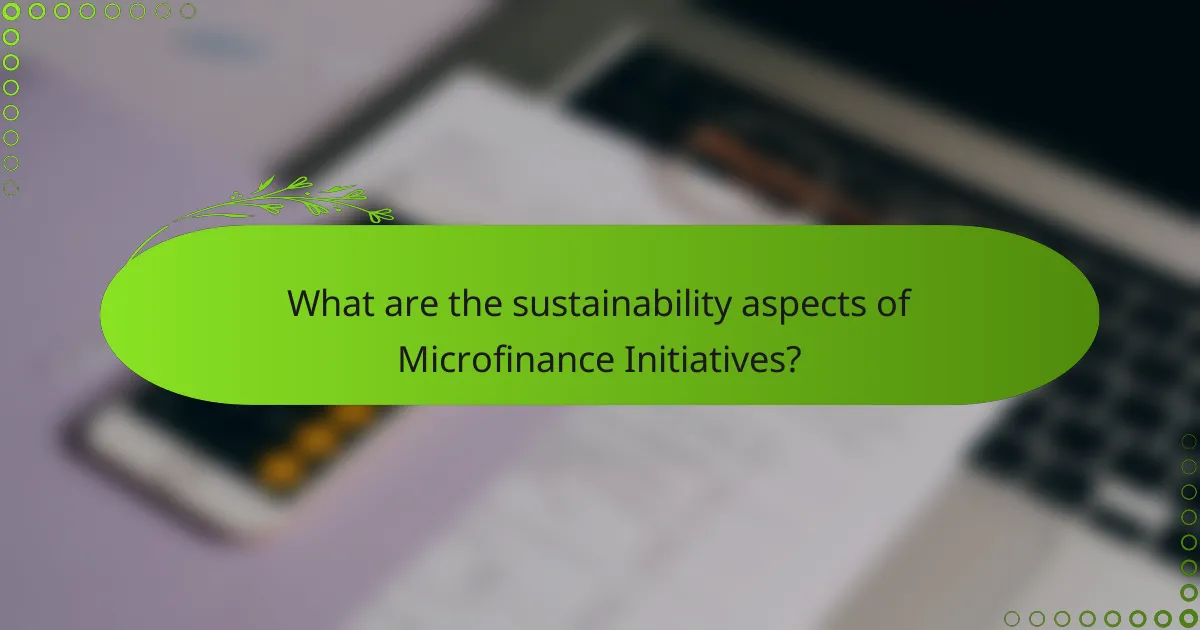
What are Microfinance Initiatives?
Microfinance initiatives are programs designed to provide financial services to low-income individuals or groups. They aim to empower the economically disadvantaged by offering small loans, savings accounts, and other financial products. These initiatives help individuals start or expand small businesses, improving their economic situation. According to the World Bank, microfinance can reduce poverty and promote entrepreneurship. Studies indicate that microfinance has lifted millions out of poverty globally. For example, the Grameen Bank model in Bangladesh has successfully provided microloans to over 9 million borrowers. These initiatives enhance financial inclusion and foster community development.
How do Microfinance Initiatives function?
Microfinance initiatives function by providing small loans to individuals or groups who lack access to traditional banking services. These loans enable borrowers to start or expand small businesses. Microfinance institutions (MFIs) assess the creditworthiness of borrowers through alternative methods, such as community recommendations. Typically, borrowers are required to participate in group lending, which fosters accountability. Interest rates on microloans are often higher than conventional loans due to the increased risk and operational costs. Many MFIs also offer financial literacy training to enhance borrowers’ business skills. According to the Microfinance Gateway, over 140 million clients worldwide benefited from microfinance services as of 2020. This demonstrates the significant reach and impact of such initiatives on poverty alleviation.
What services do Microfinance Initiatives provide?
Microfinance initiatives provide financial services to low-income individuals and small businesses. These services include microloans, which are small loans designed to support entrepreneurship. They also offer savings accounts, enabling clients to save money securely. Additionally, microfinance initiatives provide financial literacy training. This training helps clients understand budgeting and managing finances. Some initiatives offer insurance products to protect clients against risks. They may also provide access to technology and market information. These services collectively aim to empower underserved communities and promote economic development.
Who are the primary beneficiaries of Microfinance Initiatives?
The primary beneficiaries of microfinance initiatives are low-income individuals and small business owners. These beneficiaries often lack access to traditional banking services. They typically include women, rural entrepreneurs, and marginalized communities. Microfinance provides them with small loans and financial services. This support helps them to start or expand their businesses. It also enables them to improve their living conditions. Studies show that microfinance can lead to increased income and financial independence. For instance, a report by the Consultative Group to Assist the Poor indicates that microfinance significantly benefits women by empowering them economically.
What impact do Microfinance Initiatives have on communities?
Microfinance initiatives significantly improve communities by providing access to financial resources. They enable low-income individuals to start small businesses. This leads to increased income and economic stability. According to a study by the Consultative Group to Assist the Poor, microfinance can raise household income by 20% on average. Additionally, these initiatives promote financial literacy among community members. Improved financial knowledge leads to better money management. Microfinance also fosters social empowerment, particularly for women. Research shows that women who access microfinance are more likely to invest in their children’s education. Overall, microfinance initiatives create a ripple effect, enhancing community development and resilience.
How do Microfinance Initiatives contribute to poverty alleviation?
Microfinance initiatives contribute to poverty alleviation by providing financial services to underserved populations. They offer small loans to individuals who lack access to traditional banking. This enables entrepreneurs to start or expand businesses. Increased business activity leads to higher income levels. Higher income improves living conditions and access to education and healthcare. According to the Consultative Group to Assist the Poor, microfinance has lifted millions out of poverty globally. A study by the World Bank found that microfinance can increase household income by 20% on average. These initiatives empower women, fostering gender equality and economic independence.
What role do Microfinance Initiatives play in women’s empowerment?
Microfinance initiatives play a crucial role in women’s empowerment by providing access to financial resources. These initiatives enable women to start and expand businesses. Increased financial independence leads to improved social status and decision-making power. Studies show that women who access microfinance are more likely to invest in education and health for their families. According to the Microcredit Summit Campaign, 70% of microfinance clients are women. This access to capital helps reduce poverty levels among female entrepreneurs. Additionally, microfinance programs often include training and support, enhancing women’s skills and confidence. Overall, microfinance initiatives significantly contribute to gender equality and economic development.

What are the sustainability aspects of Microfinance Initiatives?
Sustainability aspects of microfinance initiatives include economic viability, social impact, and environmental responsibility. Economic viability ensures that microfinance institutions (MFIs) can operate profitably while serving low-income clients. Social impact focuses on improving the livelihoods of borrowers, often leading to poverty alleviation. A study by the Consultative Group to Assist the Poor (CGAP) found that microfinance can increase household income by up to 30%. Environmental responsibility involves promoting sustainable practices among clients, such as funding eco-friendly businesses. MFIs often incorporate training on sustainable practices, which enhances community resilience. These aspects collectively contribute to the long-term success of microfinance initiatives.
How do Microfinance Initiatives ensure financial sustainability?
Microfinance initiatives ensure financial sustainability through various strategies. They focus on creating a diverse portfolio of financial products. This includes loans, savings, and insurance tailored to client needs. They also emphasize client education on financial literacy. Educated clients are more likely to repay loans, reducing default rates. Additionally, they implement rigorous risk assessment procedures. This helps in managing loan portfolios effectively. Many microfinance institutions reinvest profits into operations to maintain sustainability. According to the Microfinance Gateway, 70% of successful microfinance institutions achieve financial sustainability within five years.
What funding sources support Microfinance Initiatives?
Microfinance initiatives are supported by various funding sources. These include government grants, which provide financial assistance to microfinance institutions. International organizations, such as the World Bank and the International Monetary Fund, also offer funding. Private investors contribute capital through equity investments. Additionally, non-governmental organizations (NGOs) often provide financial support. Crowdfunding platforms allow individuals to invest in microfinance projects. Furthermore, social impact investors seek to generate both financial returns and social benefits. Lastly, local community contributions play a role in funding these initiatives. Each of these sources helps sustain and expand microfinance programs globally.
How do Microfinance Initiatives measure their impact over time?
Microfinance initiatives measure their impact over time through various quantitative and qualitative methods. They often utilize client surveys to gather feedback on economic changes. Financial performance metrics, such as loan repayment rates, are also analyzed. Additionally, social indicators like improved education and health outcomes are tracked. Longitudinal studies help assess changes over extended periods. Impact assessments are conducted to evaluate the effectiveness of programs. These assessments often compare beneficiaries with non-beneficiaries to gauge success. Data is collected and analyzed systematically to inform future strategies.
What challenges do Microfinance Initiatives face regarding sustainability?
Microfinance initiatives face significant challenges regarding sustainability. These challenges include high operational costs, limited access to funding, and regulatory constraints. High operational costs arise from the need for extensive outreach and support services. Limited access to funding restricts the ability to scale and serve more clients. Regulatory constraints can hinder flexibility in operations and product offerings. Additionally, competition from traditional banks can impact the client base. Research indicates that around 50% of microfinance institutions struggle to achieve financial sustainability within the first few years. These factors collectively threaten the long-term viability of microfinance initiatives.
How do economic fluctuations affect Microfinance Initiatives?
Economic fluctuations significantly impact microfinance initiatives. During economic downturns, borrowers often struggle to repay loans. This increases default rates, affecting the financial stability of microfinance institutions. Consequently, these institutions may tighten lending criteria. This restricts access to credit for potential borrowers. Additionally, economic growth can enhance repayment rates. In prosperous times, borrowers have better income, leading to lower default rates. Research shows that in countries with volatile economies, microfinance initiatives face higher risks. For example, a study by the Consultative Group to Assist the Poor (CGAP) highlighted that economic instability can disrupt the operational capacity of microfinance institutions.
What are the risks associated with Microfinance lending?
Microfinance lending carries several risks, including borrower over-indebtedness. This occurs when borrowers take on more loans than they can repay. High-interest rates can exacerbate this issue, leading to financial strain. Additionally, microfinance institutions may face operational risks, such as inefficient management or inadequate funding. Regulatory risks also exist, as changes in laws can impact lending practices. Lastly, there are market risks, where economic downturns can affect borrowers’ ability to repay loans. These factors contribute to the overall risk profile of microfinance lending.

What are some notable case studies of Microfinance Initiatives?
Notable case studies of microfinance initiatives include the Grameen Bank in Bangladesh and BRAC. Grameen Bank, founded by Muhammad Yunus in 1983, provides small loans to the poor without requiring collateral. It has reached over 9 million borrowers, primarily women, improving their economic status. BRAC, also in Bangladesh, combines microfinance with social services, impacting millions through integrated programs. Another example is the FINCA International, which operates in multiple countries and focuses on providing financial services to low-income entrepreneurs. These initiatives demonstrate significant improvements in poverty alleviation and women’s empowerment through access to finance.
What successful examples of Microfinance Initiatives exist worldwide?
Grameen Bank in Bangladesh is a prominent example of a successful microfinance initiative. Founded in 1983 by Muhammad Yunus, it provides small loans to impoverished individuals without requiring collateral. As of 2021, Grameen Bank has disbursed over $24 billion in loans, helping millions escape poverty. Another successful initiative is BRAC, also in Bangladesh, which combines microfinance with education and healthcare services. BRAC has reached over 7 million clients through its microfinance program. Kiva, a global platform based in the U.S., connects lenders with borrowers in developing countries, facilitating over $1.5 billion in loans since its inception in 2005. These initiatives demonstrate the effectiveness of microfinance in promoting entrepreneurship and improving living standards.
How did specific Microfinance Initiatives improve community outcomes?
Specific microfinance initiatives improved community outcomes by providing access to financial resources for underserved populations. These initiatives enabled individuals to start small businesses, which increased local employment opportunities. For instance, the Grameen Bank in Bangladesh reported that 97% of its borrowers were able to improve their household income. Additionally, microfinance programs often include financial literacy training, enhancing the borrowers’ ability to manage funds effectively. This training has led to higher savings rates among participants, promoting financial stability. Furthermore, research from the Consultative Group to Assist the Poor found that microfinance can positively impact women’s empowerment, as women often comprise a significant percentage of borrowers. Empowered women contribute to community development by reinvesting in education and health for their families. Overall, specific microfinance initiatives have demonstrated measurable improvements in economic stability and social empowerment within communities.
What lessons can be learned from these case studies?
Case studies on microfinance initiatives reveal several key lessons. First, effective microfinance programs can significantly improve the economic status of participants. Research shows that beneficiaries often experience increased income and savings. Second, sustainability is critical for long-term success. Programs must balance social goals with financial viability to thrive. Third, tailored financial products enhance outcomes. Customizing loans and services to meet local needs leads to better user engagement. Lastly, community involvement is essential. Successful initiatives often incorporate local insights and support networks. These lessons demonstrate the importance of adaptability and community focus in microfinance.
What best practices can enhance the effectiveness of Microfinance Initiatives?
Best practices that enhance the effectiveness of microfinance initiatives include tailoring services to client needs. Understanding local market conditions improves service relevance. Training clients in financial literacy increases their ability to manage funds. Regular monitoring of client progress helps identify challenges early. Building strong relationships with clients fosters trust and loyalty. Diversifying financial products can meet various client requirements. Collaborating with local organizations strengthens community ties. Lastly, utilizing technology streamlines operations and improves accessibility. These practices lead to better outcomes for microfinance clients and contribute to overall initiative success.
How can Microfinance Institutions improve client engagement?
Microfinance institutions can improve client engagement by leveraging technology and personalized services. Implementing mobile banking solutions allows clients to access services conveniently. Regular communication through SMS updates fosters a sense of connection with clients. Offering tailored financial education programs enhances clients’ understanding of products. Creating feedback mechanisms helps institutions address client concerns promptly. Data analytics can identify client needs and preferences for better service offerings. Collaborating with local communities builds trust and increases client loyalty. Research shows that engaged clients are more likely to utilize services effectively, leading to better financial outcomes.
What strategies can increase the sustainability of Microfinance Initiatives?
Diversifying funding sources can increase the sustainability of microfinance initiatives. This strategy reduces dependence on a single income stream. Engaging in partnerships with local businesses enhances resource sharing. Implementing financial literacy programs empowers clients to manage funds effectively. Utilizing technology improves operational efficiency and reduces costs. Regularly assessing impact ensures alignment with community needs. Adopting a client-centered approach fosters loyalty and long-term relationships. These strategies collectively contribute to the resilience and longevity of microfinance initiatives.
Microfinance initiatives are programs that provide financial services to low-income individuals and groups, aiming to empower them through small loans, savings accounts, and financial literacy training. This article explores the impact of microfinance on poverty alleviation, community development, and women’s empowerment, highlighting successful case studies such as Grameen Bank and BRAC. It also examines the sustainability challenges faced by microfinance institutions, strategies for enhancing client engagement, and best practices for improving the effectiveness of these initiatives. Overall, the article provides a comprehensive overview of the role of microfinance in promoting economic stability and social empowerment.